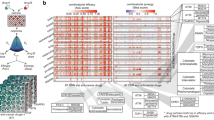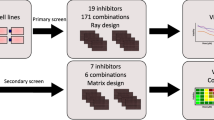Abstract
Cancer treatment generally involves drugs used in combinations. Most previous work has focused on identifying and understanding synergistic drug–drug interactions; however, understanding antagonistic interactions remains an important and understudied issue. To enrich for antagonism and reveal common features of these combinations, we screened all pairwise combinations of drugs characterized as activators of regulated cell death. This network is strongly enriched for antagonism, particularly a form of antagonism that we call ‘single-agent dominance’. Single-agent dominance refers to antagonisms in which a two-drug combination phenocopies one of the two agents. Dominance results from differences in cell death onset time, with dominant drugs acting earlier than their suppressed counterparts. We explored mechanisms by which parthanatotic agents dominate apoptotic agents, finding that dominance in this scenario is caused by mutually exclusive and conflicting use of Poly(ADP-ribose) polymerase 1 (PARP1). Taken together, our study reveals death kinetics as a predictive feature of antagonism, due to inhibitory crosstalk between cell death pathways.

This is a preview of subscription content, access via your institution
Access options
Access Nature and 54 other Nature Portfolio journals
Get Nature+, our best-value online-access subscription
$29.99 / 30 days
cancel any time
Subscribe to this journal
Receive 12 print issues and online access
$259.00 per year
only $21.58 per issue
Buy this article
- Purchase on Springer Link
- Instant access to full article PDF
Prices may be subject to local taxes which are calculated during checkout






Similar content being viewed by others
Data availability
Source data for evaluation of the mechanism by which drugs led to cell death are included in Supplementary Dataset 1. Source data for the drug combination screen in Fig. 2d are included in Supplementary Dataset th2. PCA score data related to Fig. 4a–c are included in Supplementary Dataset 3. The list of 130 SAD combinations identified in this study is included in Supplementary Dataset 4. All other data are available upon request.
Code availability
Custom analysis code for computing LF kinetics from endpoint data is included in the MATLAB script ‘backfitting and LED.m’. Other analysis code is available upon request.
References
Al-Lazikani, B., Banerji, U. & Workman, P. Combinatorial drug therapy for cancer in the post-genomic era. Nat. Biotechnol. 30, 1–13 (2012).
Roux, J. et al. Fractional killing arises from cell-to-cell variability in overcoming a caspase activity threshold. Mol. Syst. Biol. 11, 803–817 (2015).
Kummar, S. et al. Utilizing targeted cancer therapeutic agents in combination: novel approaches and urgent requirements. Nat. Rev. Drug Discov. 9, 843–856 (2010).
Pemovska, T., Bigenzahn, J. W. & Superti-Furga, G. ScienceDirect Recent advances in combinatorial drug screening and synergy scoring. Curr. Opin. Pharmacology 42, 102–110 (2018).
Lee, M. J. et al. Sequential application of anticancer drugs enhances cell death by rewiring apoptotic signaling networks. Cell 149, 780–794 (2012).
Palmer, A. C. & Sorger, P. K. Combination cancer therapy can confer benefit via patient-to-patient variability without drug additivity or synergy. Cell 171, 1678–1682 (2017).
Pritchard, J. R. et al. Defining principles of combination drug mechanisms of action. Proc. Natl Acad. Sci. USA 110, E170–E179 (2013).
Zhao, B., Pritchard, J., Lauffenburger, D. & Hemann, M. Addressing genetic tumor heterogeneity through computationally predictive combination therapy. Cancer Discov. 4, 166–174 (2014).
Michel, J.-B., Yeh, P. J., Chait, R., Moellering, R. C. & Kishony, R. Drug interactions modulate the potential for evolution of resistance. Proc. Natl Acad. Sci. USA 105, 14918–14923 (2008).
Koplev, S. et al. Dynamic rearrangement of cell states detected by systematic screening of sequential anticancer treatments. Cell Rep. 20, 2784–2791 (2017).
Miller, M. et al. Drug synergy screen and network modeling in dedifferentiated liposarcoma identifies CDK4 and IGF1R as synergistic drug targets. Sci. Signal. 6, ra85 (2013).
Jaeger, S. et al. Quantification of pathway cross-talk reveals novel synergistic drug combinations for breast cancer. Cancer Res. 77, 459–469 (2017).
Cokol, M. et al. Systematic exploration of synergistic drug pairs. Mol. Syst. Biol. 7, 1–9 (2011).
Simpkins, S. W. et al. Predicting bioprocess targets of chemical compounds through integration of chemical–genetic and genetic interactions. PLoS Comput. Biol. 14, e1006532–31 (2018).
Yin, N. et al. Synergistic and antagonistic drug combinations depend on network topology. PLoS ONE 9, e93960–e93967 (2014).
Galluzzi, L. et al. Molecular mechanisms of cell death: recommendations of the Nomenclature Committee on Cell Death 2018. Cell Death Differ. 25, 1–56 (2018).
Grootjans, S. et al. A real-time fluorometric method for the simultaneous detection of cell death type and rate. Nat. Protoc. 11, 1444–1454 (2016).
Hitomi, J. et al. Identification of a molecular signaling network that regulates a cellular necrotic cell death pathway. Cell 135, 1311–1323 (2008).
Newton, K. et al. Cleavage of RIPK1 by caspase-8 is crucial for limiting apoptosis and necroptosis. Nature 574, 1–18 (2019).
Soldani, C. & Scovassi, A. Poly(ADP-ribose) polymerase-1 cleavage during apoptosis: an update. Apoptosis 7, 321–328 (2002).
Forcina, G. C., Conlon, M., Wells, A., Cao, J. & Dixon, S. J. Systematic quantification of population cell death kinetics in mammalian cells. Cell Syst. 4, 1–18 (2017).
Wlodkowic, D., Faley, S., Darzynkiewicz, Z. & Cooper, J. M. Real-time cytotoxicity assays. Methods Mol. Biol. 731, 285–291 (2011).
Louandre, C. et al. Iron-dependent cell death of hepatocellular carcinoma cells exposed to sorafenib. Int. J. Cancer 133, 1732–1742 (2013).
Chiu, L.-Y., Ho, F.-M., Shiah, S.-G., Chang, Y. & Lin, W.-W. Oxidative stress initiates DNA damager MNNG-induced poly(ADP-ribose)polymerase-1-dependent parthanatos cell death. Biochem. Pharmacol. 81, 459–470 (2011).
Eling, N., Reuter, L., Hazin, J., Hamacher-Brady, A. & Brady, N. R. Identification of artesunate as a specific activator of ferroptosis in pancreatic cancer cells. Oncoscience 2, 517–532 (2015).
Berghe, T., Linkermann, A., Jouan-Lanhouet, S., Walczak, H. & Vandenabeele, P. Regulated necrosis: the expanding network of non-apoptotic cell death pathways. Nat. Rev. Mol. Cell Biol. 15, 135–147 (2014).
Jouan-Lanhouet, S. et al. TRAIL induces necroptosis involving RIPK1/RIPK3-dependent PARP-1 activation. Cell Death Differ. 19, 1–12 (2019).
Dixon, S. J. et al. Ferroptosis: an iron-dependent form of nonapoptotic cell death. Cell 149, 1060–1072 (2012).
Axelrod, M. et al. Combinatorial drug screening identifies compensatory pathway interactions and adaptive resistance mechanisms. Oncotarget 4, 622–635 (2013).
Laster, S., Wood, J. & Gooding, L. Tumor necrosis factor can induce both apoptotic and necrotic forms of cell lysis. J. Immunol. 141, 2629–2634 (1988).
Wei, M. et al. Proapoptotic BAX and BAK: a requisite gateway to mitochondrial dysfunction and death. Science 292, 727–730 (2001).
Russ, D. & Kishony, R. Additivity of inhibitory effects in multidrug combinations. Nat. Microbiol. 3, 1–9 (2018).
Chou, T.-C. & Talalay, P. Quantitative analysis of dose–effect relationships: the combined effects of multiple drugs or enzyme inhibitors. Adv. Enzym. Regul. 22, 27–55 (1984).
Tallarida, R. J. The interaction index: a measure of drug synergism. Pain 98, 163–168 (2002).
Chou, T.-C. Drug combination studies and their synergy quantification using the Chou–Talalay method. Cancer Res. 70, 440–446 (2010).
Baeder, D. Y., Yu, G., Hozé, N., Rolff, J. & Regoes, R. R. Antimicrobial combinations: Bliss independence and Loewe additivity derived from mechanistic multi-hit models. Philos. Trans. R. Soc. B Biol. Sci. 371, 20150294-11 (2016).
Lederer, S., Dijkstra, T. M. & Heskes, T. Additive dose response models: explicit formulation and the Loewe additivity consistency condition. Front. Pharmacol. 9, 31 (2018).
O’Neil, J. et al. An unbiased oncology compound screen to identify novel combination strategies. Mol. Cancer Ther. 15, 1155–1162 (2016).
Holbeck, S. L. et al. The National Cancer Institute ALMANAC: a comprehensive screening resource for the detection of anticancer drug pairs with enhanced therapeutic activity. Cancer Res. 77, 3564–3576 (2017).
Menden, M. P. et al. Community assessment to advance computational prediction of cancer drug combinations in a pharmacogenomic screen. Nat. Commun. 10, 1–17 (2019).
Rees, M. G. et al. Correlating chemical sensitivity and basal gene expression reveals mechanism of action. Nat. Chem. Biol. 12, 109–116 (2016).
Wang, Y. et al. A nuclease that mediates cell death induced by DNA damage and poly(ADP-ribose) polymerase-1. Science 354, aad6872 (2016).
Zimmermann, M. et al. CRISPR screens identify genomic ribonucleotides as a source of PARP-trapping lesions. Nature 559, 285–289 (2018).
Merino, D. et al. BH3-mimetic drugs: blazing the trail for new cancer medicines. Cancer Cell 34, 879–891 (2018).
Farmer, H. et al. Targeting the DNA repair defect in BRCA mutant cells as a therapeutic strategy. Nature 434, 917–921 (2005).
Yap, T. A., Plummer, R., Azad, N. S. & Helleday, T. In American Society of Clinical Oncology Educational Book 185–195 (2019)
Landry, B. D. et al. Tumor–stroma interactions differentially alter drug sensitivity based on the origin of stromal cells. Mol. Syst. Biol. 14, e8322-15 (2018).
Marusyk, A. et al. Spatial proximity to fibroblasts impacts molecular features and therapeutic sensitivity of breast cancer cells influencing clinical outcomes. Cancer Res. 76, 6495–6506 (2016).
Lehmann, B. D. et al. Identification of human triple-negative breast cancer subtypes and preclinical models for selection of targeted therapies. J. Clin. Invest. 121, 1–18 (2011).
Hafner, M., Niepel, M., Chung, M. & Sorger, P. K. Growth rate inhibition metrics correct for confounders in measuring sensitivity to cancer drugs. Nat. Methods 13, 1–11 (2016).
Acknowledgements
We thank current and past members of the Lee labotatory and all members of PSB for their helpful comments and critiques during the execution of this study. In addition, we thank M. Walhout, J. Dekker, A. Mitchell and J. Pritchard for their thoughtful comments during the preparation of this manuscript. The px330-puro-hSpCas9 plasmid was a kind gift from T. Fazzio (UMass Medical School). This work was supported by the National Institute of General Medical Sciences of the National Institutes of Health (R01GM127559 to M.J.L.); the American Cancer Society (RSG-17-011-01 to M.J.L.); and an NIH/NCI training grant (Translational Cancer Biology Training Grant, T32-CA130807 to R.R., B.D.L. and P.C.G.).
Author information
Authors and Affiliations
Contributions
This project was conceived by R.R. and M.J.L. Combinatorial drug screening was designed, executed and analyzed by R.R., B.D.L. and P.C.G., and M.J.L. helped with the execution of the combination drug screen. Imaging experiments and STACK analysis were performed by R.R. and H.R.S. Drug evaluation and annotation of the drug mechanism of action were performed by R.R., A.J.J., P.C.G. and M.S.S. Flow cytometry-based analyses were performed and analyzed by R.R. and M.E.H. All other statistical analysis and modeling were conducted by R.R., M.E.H. and M.J.L. R.R. and M.J.L. wrote and edited the manuscript.
Corresponding author
Ethics declarations
Competing interests
The authors declare no competing interests.
Additional information
Publisher’s note Springer Nature remains neutral with regard to jurisdictional claims in published maps and institutional affiliations.
Supplementary information
Supplementary Information
Supplementary Figs. 1–14 and Supplementary Tables 1–3.
Supplementary Dataset 1
Drug responses in U2OS WT and DKO cells.
Supplementary Dataset 2
Combination drug screen.
Supplementary Dataset 3
PCA scores for drugs and drug combinations.
Supplementary Dataset 4
SAD combinations in U2OS cells.
Rights and permissions
About this article
Cite this article
Richards, R., Schwartz, H.R., Honeywell, M.E. et al. Drug antagonism and single-agent dominance result from differences in death kinetics. Nat Chem Biol 16, 791–800 (2020). https://doi.org/10.1038/s41589-020-0510-4
Received:
Accepted:
Published:
Issue Date:
DOI: https://doi.org/10.1038/s41589-020-0510-4
This article is cited by
-
The death gaze of MEDUSA
Nature Chemical Biology (2024)
-
Functional genomic screens with death rate analyses reveal mechanisms of drug action
Nature Chemical Biology (2024)
-
Quick tips for interpreting cell death experiments
Nature Cell Biology (2023)
-
Analysis and modeling of cancer drug responses using cell cycle phase-specific rate effects
Nature Communications (2023)
-
Effect of storage age and containers on the physicochemical degradation of guggul oleo-resin
Scientific Reports (2023)



